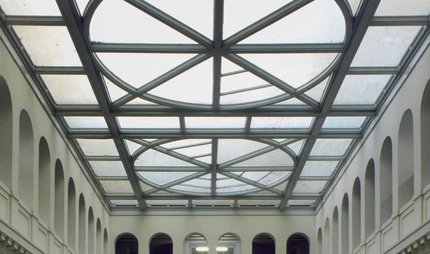
Titania-Palast
Lichts of the big city
The Titania-Palast is one of the few remaining Berlin cinemas from the glamorous early days of sound film.
Berlin during the Golden Twenties. The metropolis beckoned and people flocked to the cinemas. In 1927/28, at the transition from the era of silent films to sound films, a picture palace was built in Steglitz, whose luxurious furnishings made going to the cinema a truly special experience.
Austere form and sophisticated light architecture
The architects Ernst Schöffler, Carlo Schloenbach and Carl Jacobi designed the exterior of the Titania-Palast with the striking forms of New Objectivity. Typical of 1920s architecture is the assembly of several cube-shaped structures. The simple façades were divided by horizontal wall strips, crossed by narrow, vertical windows, while in the lower third, these were framed by round arches. In 1928, the architecture critic Leo Adler mocked the "confusion of the outer appearance".
The most unusual feature of the building is the approximately 30-metre-high tower at the corner of the building. Its descriptions range from "steamer chimney" to "ladder to heaven".
At night, the building transformed and revealed the aspect that Schöffler, Schloenbach and Jacobi wanted to focus on in the Titania-Palast: the light architecture. The electric light, symbol of the pulsating city of Berlin, was used in different ways. 27 opal glass light strips turned the corner tower into a light tower at night, making the cinema visible from afar. The cinema name TITANIA PALAST was mounted in neon tubes, while the announcements for the films above the entrance also lit up.
Even Leo Adler, who otherwise did not have much good to say about the building, stressed appreciatively:
"In the use of modern lighting technology, the Titania-Palast in Steglitz can for the time being indeed be described as a crowning achievement."
Luxury and organic elements
As a result of reconstruction in the 1950s and 1960s, nothing has remained of the interior of the Titania-Palast. In January 1928, when the cinema opened with the screening of the silent film Der Sprung ins Glück (The Leap into Happiness), the film stars and premiere guests were surprised by the contrast between the austere, functional exterior of the building and the luxuriously furnished cinema hall inside.
A large Art Deco foyer, walls covered with red velour and gilded elements conveyed exclusivity. Intended to hold around 2,000 audience members, the hall was designed in soft, organically flowing forms: a round light dome on the ceiling, curved walls and shell-shaped arches around the screen transported the audience in those days to a temple of the modern medium of film.
Cultural significance of the Titania-Palast
From its opening until the post-war period, the Titania-Palast was more than just a cinema: it became an important cultural centre in Steglitz. Before the Second World War, theatre performances were held here in addition to film screenings. In October 1929, the first sound film flickered onto the screen. The cinema was even designed to accommodate an orchestra of up to 60 people. Not least for this reason, in May 1945 it provided the venue for the Berlin Philharmonic's first post-war concert. And on December 4, 1948, the founding ceremony of the Freie Universität Berlin took place in the Titania-Palast.
After the reconstruction of the sixties, retail stores rented the rooms for several decades. In the mid-1990s, plans were drawn up for conversion and renewed use as a cinema, and in 1995 the first film screening in 30 years took place. Today's cinema has seven projection halls and the only things it has in common with the Titania-Palast of the 1920s are the façade and the name.
Our tips for nearby the Titania-Palast
After a visit to the Titania-Palast, Schloßstraße in Steglitz is calling for a shopping spree. Very close you will find the district’s landmark: the Bierpinsel, a tower in 1970s architectural style.
Are you interested in seeing further examples of Berlin cinema architecture? Kino International and the former Kino Kosmos from the 1960s are located in Karl-Marx-Allee. Standing at Rosa-Luxemburg-Platz in Berlin-Mitte is the Babylon, formed in the New Objectivity style, built at the same time as the Titania-Palast.
Practical information from visitBerlin
You can reach the Titania-Palast by U-Bahn line 9 to Walther-Schreiber-Platz. To explore the city, we recommend the Berlin Welcome Card for public transport.



